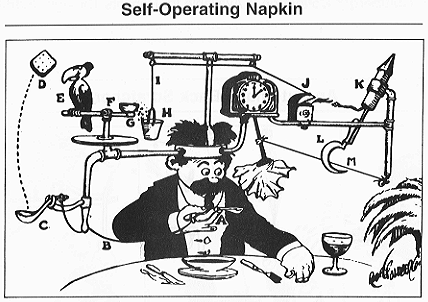It’s time to get creative! This week we explore the wonderful world of Rube Goldberg Machines (RGM).
Classic Rube Goldberg device (Professor Butts and the Self-Operating Napkin (1931))
Reuben Goldberg was a cartoonist, sculptor, author, engineer and inventor. He is most famous for his comics the featured outlandishly complicated devices meant to carry out simple tasks.
Today Rube Goldberg is synonymous with delightful unhinged creative feats of engineering.
The weather is fine, so gather up whatever supplies you have (anything, literally anything you can find lying around can be used in a Rube Goldberg Machine) and start building!
Want to learn more about the world of Rube Goldberg? Check out the web site dedicated to his legacy which includes information about contests, activities you can do at home, links to amazing machines and much more.
Learn about the Science behind Rube Goldberg Machines
Types of energy. Explore the ways energy is at play in your Rube Goldberg Machine.
Understanding Energy Transfer in RGMs.
Examples of Rube Goldberg Machines
Small Rube Goldberg Machines (inspiration for parts of your larger machine)
Don’t have a lot of space? Hayfever keeping you inside? Never fear you can use the worlds favorite video game to build COLLOSSAL RGMs. That cow looks like it’s having fun, right?
Legos! Everyone’s favorite building system is a great place to start your wacky Rube Goldberg journey. Check out this RGM build by Lego masters.
Want to start with something a little simpler? Try this tutorial from Tinker Lab.
The Swish Machine - Basketball Trick Shot
Worlds smallest RGM using 1,200 mechanical watch parts
World’s Largest RGM lights a Christmas Tree.
Think RGMs are useless goofs? Not so. See how RGMs can aid in social distancing.
Challenge!
Incorporate these types of energy transfer into your RGM!
Electrical Energy (use a motorized device!)
Light Energy - trip a sensor or burn a string with a magnifying glass (be safe!)
Sound! Shake rattle and roll! Use speaker to vibrate your machine into motion
Gravity! As they say, what goes up, must come down!
Elastic Energy
Step Challenge! Build a machine with 20 steps. Then 40! How many steps can you get?
Time challenge! Build a fast machine with 10 steps or more. Build a slow machine with less than 10 steps.
Build a tiny RGM inside a box
Artistic RGM. Build an RGM with a visual theme. Maybe when you step back the machine looks like an octopus, or maybe a marble travels along the Great Wall! Use your own inspiration.
Build a huge machine that travels through your yard, or home, or the park


























